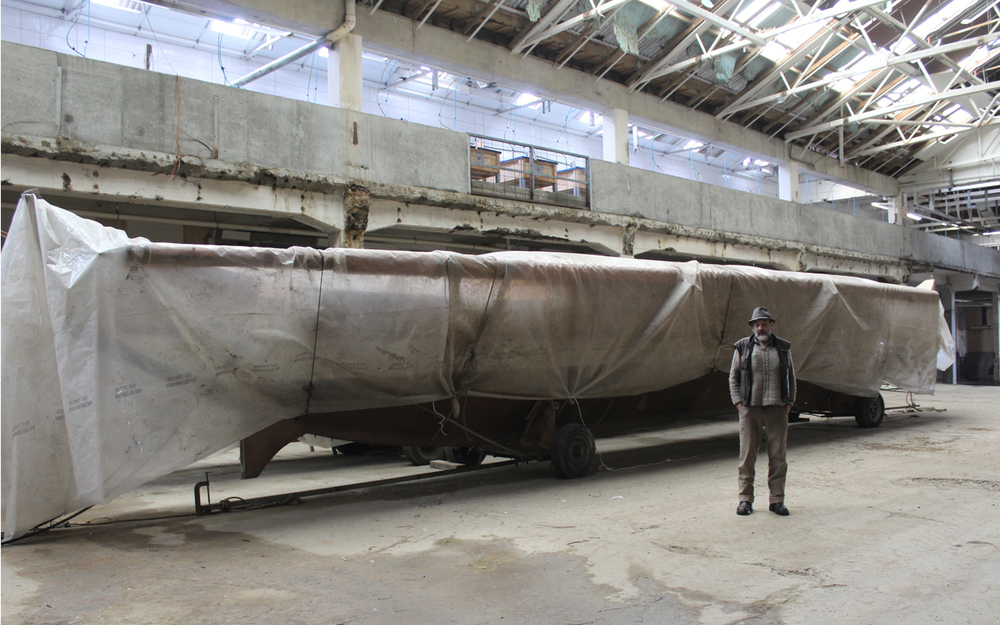The old man, the waka and the sea
Local Democracy Reporter
29 November 2021, 5:41 AM
 Stoney Bourke has been working on his twin hull waka for almost 30 years. Photo: Matthew Rosenberg/LDR
Stoney Bourke has been working on his twin hull waka for almost 30 years. Photo: Matthew Rosenberg/LDROne kilometre of fibreglass cloth, 175 sheets of marine ply, 900 litres of epoxy and 28 years of hard work — but the project remains incomplete. Stoney Bourke is getting old, and so is his waka.
It sits in an old warehouse on the side of Bluff Highway, 63ft (19.2m) in length, elevated above the cold concrete by two large trailers.

Over 60ft (18m) long, the waka sits inside an old freezing works building on the Bluff Highway. Photo: Matthew Rosenberg/LDR
The freezing works have long cleared out, replaced in recent years by an abalone (pāua) farm.
"It sounds like you’re underwater," Bourke muses, as the hum of running water from pāua tanks echoes through the expanse.
The observation is something of an analogy for the predicament the 70-year-old boat builder finds himself in.
Advertisement: Bronze Connection
Bourke is struggling to keep his project afloat, and doubt is beginning to creep in that he will ever finish it.
The project cost him his home and his community. His wife even moved to Australia to help fund it. Now he’s unsure if he’ll see it launch in his lifetime.
"I'm in a position where I’m 70, I'm tired ... and my darling wife has died. I’ve got no-one to show off to. If anything happens to me now, it [the waka] is totally in limbo."
Advertisement: DT King
As Bourke pulls the large sliding door of the warehouse closed, it’s unclear how long it will be before he returns. These days it’s less and less often because he doesn’t feel safe climbing the ladder alone.
Sitting outside in the car, he smokes a dart and reflects on his long and varied life, and the waka at the centre of it.
It all started in 1961, at Waitata Bay in Pelorus Sound, Marlborough.
Bourke remembers that when he was about 10 years old, there was a bulldozer working on a track near the family home, unearthing Maori stone tools in the process.
Advertisement: First in Windsor
"We were no neighbours, no roads, no power. We were correspondence students. However, the correspondence school library asked what your interests were, and they sent you books.
"My interest was early New Zealand history. And that’s the reason for building now, really, because of those stone tools."
Fast forward to 1993 and Bourke, by then in his early 40s, was living in Manapouri having quit the commercial fishing industry for ethical reasons.
Advertisement: Maiden Stone
It was there he had the vision of constructing a waka that would serve as a "floating classroom" for young people, providing an overnight cultural experience in Fiordland and a taste of living off the ocean.
Eventually, Bourke planned to sell the waka and set himself up for retirement.
But before that, the plan was to launch in Lake Manapouri, sail to the West Arm, disassemble and transport over the hill to Deep Cove where he would operate his dream by koha.

The waka was moved from Manapouri to Bluff about 10 years ago. Photo: Matthew Rosenberg/LDR
At the time, he was working shifts on charters and had time on his side. Supported by a community of volunteers, he was confident he could complete the project within six years. But trouble wasn't far off.
After constructing a tunnel house to protect the work in progress, Bourke found himself at odds with the Southland District Council.
Under the still relatively new Resource Management Act, it did not approve of him building the waka in his backyard without consent, and back and forth it went.
Advertisement: Jumper Co
For his third consent, he hired a consultant to represent him at a cost of $8000, and was supported by 200 submissions from Manapouri locals — some of whom had lent a hand on the project.
"The community was helping us build it, from children to retired accountants."
However, the situation had reached a tipping point.
Bourke and his wife were running out of money, and were faced with the quandary of how to keep the project going with dwindling funds. It ended up costing them their home.
Advertisement: Glengarry Pharmacy
Waving goodbye to Manapouri, and the community that had helped them get the wheels spinning, they bought in Bluff 10 years ago for $100,000, which freed up funds.
Bourke says he has also claimed considerable amounts back through GST.
But more change was afoot. Not long after arriving at the southern tip of the country, His wife Megan made a profound personal sacrifice to help see the project through to completion.
Advertisement: Penny Shanks Ray White Real Estate Te Anau
"One day my wife stamped her feet and said 'I'm going to get a job in a gold mine in Australia to fund this'.
And she did, but within a year and a-half she came home with cervical cancer.
She moved over there ... just to keep it going. We were two halves of the same battery, Megan and I, and I’ll always miss her."
Before she died, Bourke says, his wife told him that whatever happened to the waka, the journey had been worthwhile because it had brought so many good characters into their lives.
Advertisement: Te Anau Panel Beaters
More than 400 people have signed the project’s visitor’s book, and while it is yet to set foot in the ocean, Bourke remains philosophical.
"It doesn’t matter if I don’t [finish the project]. The journey’s been worth it. Someone will finish it."
The twin-hull waka is 63ft (19.2m) long and 28ft (8.5m) across when connected — about the same size as the ferries which go between Bluff and Stewart Island, Bourke reckons. It was designed by James Wharram of Cornwall, England.
Propelled through the water by sails suspended from 52ft (15.8m) kauri masts, Bourke says it is virtually unsinkable.
Advertisement: Ten Ten Thai Street Food
The masts are a story in and of themselves. Bourke sourced the wood from Totara North but hit a speed bump when he found out the maximum length he would be able to transport was 30ft (9.1m).
A solution was found by transporting the wood in smaller sections and overlapping the joins, and the rest is history.
"If you go slowly, you make small mistakes," he concludes.
Matthew Rosenberg
Local Democracy Reporting Editor
Republished by Arrangement














